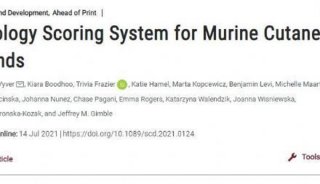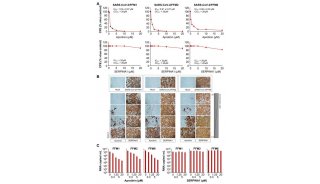Multicolour 3D-FISH in vertebrate cells-3
Pepsin treatment
Equilibrate slides (kept in 50%FA/2xSSC) in 2xSSC 2 minutes;
Switch to 1xPBS 3 minutes;
Pepsin: 3-5 minutes in 0.01 N HCl/0.002% pepsin. (prepare 49.5ml H2O + 0.5ml 1NHCl at 37°C and add 10ml pepsin solution (stock solution 10%) just before use);
2x5 minutes PBS/MgCl2 (95ml 1xPBS/5ml 1M MgCl2) for inactivation of pepsin;
Post-fixation in 1% PFA/1xPBS 1 minute;
Wash 1x5 minutes PBS;
Wash 2x5 minutes in 2xSSC, then back to 50%FA/2xSSC for at least 30 minutes.
Pretreatment for FISH on tissue sections
We also established working protocols for FISH on paraffin embedded tissue sections and vibratome tissue sections. In our hands we prefer FISH on vibratome sections rather than on paraffin embedded sections, but since human pathological material is up to now routinely embedded in paraffin, there may be no option for the tissue of interest. Upcoming procedures from the pathologists should help in the near future (see figure 6 and figure 7).
Treatment of paraffin sections for FISH (see comment 4)
Deparaffinize sections in 100% Xylol (3x15 minutes) and re-hydrate in ethanol series: 100% (2x15 minutes), 70% (1x15 minutes), dH2O;
Permeabilize tissue with freshly made 1M NaSCN (sodium isothiocyanate) at 80°C for 30 minutes and then rinse in dH2O;
Digest sections with 14mg/ml Pepsin (in 0.01N HCl) at 37°C for 30 minutes and then rinse in dH2O;
Dehydrate slides in ethanol series (70% and 100% for 10 minutes each) and dry slides at RT.
Treatment of vibratome sections for FISH
Vibratome sections are stored in PBS containing 0.04% Na Azide at +4°C. For drying sections on slides, transfer sections to dH2O for 5 minutes, then dehydrate in ethanol series: 30%, 50% for 10 minutes in each, and then in 2 changes of 70% for 30 minutes each. Then transfer sections on SuperFrost® Plus slides in a drop of 70% ethanol, spread sections with thin brushes, and dry sections at RT for 1-2 days;
Re-hydrate sections in 10mM Na-Citrate buffer pH 6.0 for 15 minutes. Place slides in microwave safe plastic container filled with warmed up to 80°C 10mM Na-Citrate buffer, and heat up the preparations for 6 minutes at 700W in the microwave oven. Repeat the heating procedure 5 times, re-filling the container with warmed buffer each time. The slides must be completely covered with liquid to avoid drying of sections during the whole procedure. After heating, cool slides down at RT;
Equilibrate sections in 2xSSC for 5 minutes and then in 50% formamide/2xSSC for 1-3 hours.
Probe precipitation
We recommend using 40-60ng/µl hybridization mix of non-repetitive probe DNA. Usually 2µl of labeled PCR-product per 1µl hybridization mix is reasonable for chromosome painting probes or locus-specific probes and 1ng/µl for centromere specific and other highly repetitive sequences. It may be helpful to increase the concentrations for small, non-repetitive probes. The concentration of unlabeled competitor DNA (e.g. Cot-1DNA) added to the probe for suppression of nonspecific hybridization depends on the presence of repetitive sequences in the probe and is around 10 up to 50-fold the concentration of the probe DNA. However, in case of complex probe mixtures it is assumed that probes suppress each other and the amount of COT-1 DNA can be reduced. A volume between 5-10µl of hybridization mix is normally assessed, but larger volumes for frequently needed probes work as well.
Probe precipitation (see note 15 and note 16 and comment 5)
Pipette into a 1.5ml screw cap tube all labeled DNA-probes that will be hybridized together. We recommend the following amounts:
40-60 ng/µl hybridization mix (hybmix) of non-repetitive probe DNA (such as paints, BACs etc);
1ng/µl hybmix for centromere specific and other highly repetitive sequences;
80-200ng/µl hybmix for small DNA-probes from cosmids or plasmids clones;
Unlabeled competitor DNA (e.g. Cot-1DNA, 10-50 fold the concentration of the probe DNA);
In case of small amounts of DNA add 20µg unlabeled salmon sperm DNA for efficient precipitation;
Precipitate probe DNA in ice-cold 100%EtOH (2.5x volume) and mix well -> at least 30 minutes, better O/N at -20°C;
Spin down 20 minutes at 13,000rpm;
Discard supernatant and dry the pellet (vacuum if possible);
Resuspend the pellet in 50% formamide/2xSSC/10% dextran sulfate as follows: resolve the pellet in the appropriate amount of 100% formamide (shake at 40°C, can take up to a few hours) and then add the equal volume of 4xSSC/20% dextran sulfate;
Hybridization probes can be stored at -20°C over a long period of time.
Set up of hybridization
Cellular DNA and probe DNA can be denatured simultaneously even in case of probes that require high excess of Cot1-DNA. The simultaneous denaturation of probe and cellular DNA is quick, simple, and optimal for retention of 3D morphology. We provide protocols for the hybridization set-up for cultured cells as well as for sections, which differ in some aspects depending on how sections were prepared. In most cases separate denaturation can be avoided except for cases where pre-annealing of a given probe DNA provides an extra benefit to reduce nonspecific hybridization (see note 17).
Hybridization set up by simultaneous denaturation (see comment 6)
Cultured cells;
Alternative method: In case cells are grown on a small cover slip (e.g. 15x15 or 18x18mm) you can place the drop of hybridization mix directly on a microscopic slide and then cover this drop with the cover slip with the cells facing the drop. It is also possible to cut the cover slip with the cells to the appropriate size prior to hybridization;
Wipe off the excess fluid around the coverslip and seal with rubber cement. Let the rubber cement dry completely;
Place slides on a hot block with exactly regulated temperature and denature cellular and probe DNA at 75°C for 2-4 minutes;
Hybridize at least overnight or better for 2-3 days at 37°C;
Place hybmix on a coverslip (e.g. 4µl per 18x18mm);
Take a slide out of the 50% formamide/2xSSC and quickly drain the excess of fluid off the slide;
Cover the target area of the slide by the coverslip with probe;
Paraffin embedded and cryo- tissue sections;
Load probe on the section, cover section with coverslip, and seal with rubber cement. Dry up rubber cement completely;
Pre-hybridize sections with loaded probe for few hours at +37°C before denaturation. Denature cellular DNA and probe DNA simultaneously on a hot block at 85°C for 5 minutes;
Hybridize sections for 2-3 days at 37°C in metal boxes floating in a 37°C water bath;
Vibratome tissue sections;
Prepare glass-chamber for hybridization. The chamber consists of small pieces of a coverslip with glued glass strips on both sides of the coverslip. Glass strips are prepared from coverslips using a diamond cutter and glued using nail polish (see figure 8);
Take out slides from 50% formamide/2xSSC, remove excess of liquid using soft paper, cover section with the chamber, and fill in chamber with hybridization mixture (see scheme below). Typically, 5-10µl of hybridization mixture is sufficient to fill the chamber. Seal mounted chamber with rubber cement; dry the rubber cement at RT;
Pre-hybridize sections with loaded probe for few hours at 40-45°C before denaturation. Denature cellular DNA and probe DNA simultaneously on a hot block at 85°C for 5 minutes;
Hybridize sections for 2-3 days at 37°C in metal boxes floating in a 37°C water bath;
For all material;
After hybridization, carefully remove glass chambers with fine forcepsand perform after-hybridization washings of required stringency. Typically, washings include three changes of 2xSSC at 37°C for 10 minutes each and 0.1xSSC at 60°C for 10 minutes.
Separate of probe DNA and target DNA denaturation (see note 18 and comment 6)
Denature hybridization mix at 75°C for 5 minutes and allow it to pre-anneal at 37°C for 30-60 minutes. Place the pre-annealed probe on a coverslip just before or during target DNA denaturing;
Denature nuclear DNA in 70% formamide/2xSSC for 2-3 minutes at 70°C;
Take the denatured slide and quickly drain off the excess of fluid;
Cover the target area of the slide by the coverslip with hybridization mix;
Wipe off the excess fluid around the coverslip with soft paper and seal with rubber cement;
Hybridize at least overnight or better for 2-3 days at 37°C.
-
科技前沿

-
科技前沿










